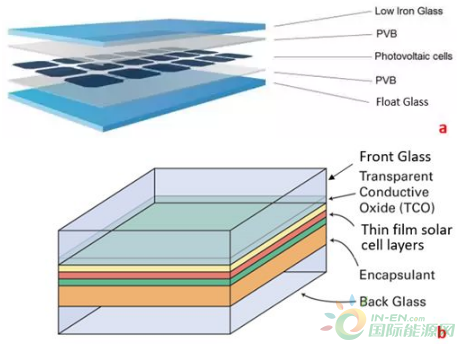随着光伏技术的不断进步和光伏产业的迅猛发展,近年来建筑一体化半透明光伏窗(简称光伏窗或“光伏发电玻璃”)吸引了越来越多的研究人员和生产厂家的高度关注,图1展示了一些典型的半透明光伏窗应用案例。简单来说,光伏窗是指使用由双层玻璃封装的半透明光伏组件来取代传统玻璃而构成的窗户系统,图2给出了常见晶体硅和薄膜半透明光伏组件的组成结构。光伏窗不透明(或半透明)的电池部分可以通过光伏效应发电,而透明(或半透明)部分则可以实现自然采光以及室内外的视觉交流。与其他先进窗户技术相比,光伏窗的最大特点是可以通过光伏作用主动将一部分太阳辐射转变为有用的电能。

图1 典型的半透明光伏窗应用案例(来源:视觉中国)
图2 常见晶体硅和薄膜半透明光伏组件结构示意图
(a, 晶体硅半透明组件;b, 薄膜半透明组件)
半透明光伏窗的发电性能受太阳能电池种类、组件透过率、太阳辐照强度以及建筑朝向等因素影响。根据组件透过率高低,目前已经商业化的晶体硅、非晶硅和碲化镉半透明光伏组件的能量转换效率大约为8-17%,5-9%和7-14%。研究人员对印度地区使用不同透过率的碲化镉半透明光伏窗的能效进行了深入研究,结果表明效率为9.9%的南向碲化镉光伏窗的年最大发电量可以高达119.6 kWh/m2。效率为6%的南向半透明非晶硅光伏窗在香港和美国旧金山湾区[3]的年发电量分别为38 kWh/m2 和65 kWh/m2。
在安装角度和透光需求等不利因素影响下,虽然单位面积的光伏窗的发电量要比传统的以最佳倾斜角安装的光伏系统的发电量低,但是光伏窗除了可以发电外,更重要的是具有很好的建筑节能效果。
一方面,它可以通过减少室内太阳得热而降低空调制冷能耗。半透明光伏窗的平均太阳得热系数仅为0.25 甚至更低,远远低于普通玻璃窗的太阳得热系数(0.85)和low-e双层中空玻璃窗的太阳得热系数(0.364)。相比传统玻璃窗,半透明光伏窗在香港可以节约61%的空调制冷能耗,在日本可以节约54%的空调制冷能耗,在巴西可以节约高达43%的能耗[6],在印度可以减少60.4%的净能耗,在韩国可以减少47%的能耗需求 ,在地中海区域可以减少59%的能耗,在美国旧金山湾区可以减少50%的空调制冷能耗。相比于普通中空玻璃窗,非晶硅半透明光伏窗在国内5大气候区的平均节能率也高达30%以上。
另一方面,合理设计的光伏窗还可以最大程度地利用自然采光并改善视觉不舒适性。Didone等关于非晶硅光伏窗自然采光效果的研究表明:采用光电传感器和自动调暗系统对人工照明加以控制之后,光伏窗可以恰到好处地利用自然采光从而减少人工照明能耗以及相应的照明空调负荷。Do等 报道半透明光伏窗与自动调暗系统结合使用可以减少3%-14%的人工照明能耗,同时可以将房间峰值冷负荷降低14%-26%,因此半透明光伏窗的应用可以进一步降低空调系统设备容量,从而实现更大程度节能。Schmid和Uehara[13]的研究结果表明使用光伏窗的房间持续自然光可用度(continuous daylight availability, cDA)仅降低4.9%-6%,但是其平均眩光指数(average daylight glare index)则下降23.3%-30.3%。这意味着,相比传统玻璃窗,使用光伏窗虽然会稍微增加一点人工照明能耗,但是其可以大大降低窗户的视觉不舒适性。美国劳伦斯伯克利国家实验室的实验研究表明,优化设计的半透明光伏窗可以有效改善视觉不舒适性,因此可以同时充当内部遮阳的功能,节约了窗帘成本。
综上所述,一个优化设计的光伏窗不仅可以发电,还可以通过降低太阳得热量和调控入射太阳辐射从而减少建筑物空调能耗、改善自然采光效果和提高视觉舒适性。笔者在香港和美国旧金山地区的研究结果表明,光伏窗所带来的能量收益中只有1/3是来自于发电,另外2/3的收益来自于空调节能。因此,光伏窗为零能耗建筑以及具有较大窗墙比的高层办公建筑节能提供了一个非常好的建筑节能解决方案。
目前限制光伏窗大规模应用的另一个重要因素就是成本问题。然而实际上太阳能电池本身所增加的成本已经非常低,一般不超过500 RMB/m2, 大部分成本可能来自于生产难度增加所导致的工艺成本上升。因此,随着半透明技术的进一步发展以及电池效率的进一步提高,光伏窗的能效性能还有很大的提升空间,相应地,其投资回收期也会进一步缩短,届时将在零碳建筑和绿色建筑领域具有广阔的发展前景。
参考文献:
[1] Sankar Barman, Amartya Chowdhury, Sanjay Mathur,Jyotirmay Mathur. Assessment of the efficiency of window integrated CdTe basedsemitransparent photovoltaic module. Sustainable Cities and Society 2018; 37:250-262.
[2] Jinqing Peng, Lin Lu, Hongxing Yang, Tao Ma. Comparative study of thethermal and power performances of a semi-transparent photovoltaic facade underdifferent ventilation modes. Applied Energy 2015; 138: 572-583.
[3] Apte J, Arasteh D (2006). Window-Related Energy Consumption in the USResidential and Commercial Building Stock. Berkeley, CA, Lawrence BerkeleyNational Laboratory: LBNL-60146.
[4] Chow T T, Pei G, Chan L S, Lin Z, Fong K F. A comparative study of PVglazing performance in warm climate. Indoor and Built Environment 2009; 18(1): 32-40.
[5] T.Miyazaki, A. Akisawa, T. Kashiwagi, Energy savings of office buildings by theuse of semi-transparent solar cells for windows. Renewable Energy 2005; 30(3):281–304.
[6] EveliseLeite Didone, Andreas Wagner. Semi-transparent PV windows: A study for officebuildings in Brazil. Energy and Buildings 2013; 67: 136-142.
[7] SankarBarman, Amartya Chowdhury, Sanjay Mathur, Jyotirmay Mathur. Assessment of theefficiency of window integrated CdTe based semitransparent photovoltaic module.Sustainable Cities and Society 2018; 37: 250-262.
[8] Jong-Ho Yoon, Jonghwa Song, Sung-Jin Lee.Practical application of building integrated photovoltaic (BIPV) system usingtransparent amorphous silicon thin-film PV module. Solar Energy 2011; 85: 723-733.
[9] Jinqing Peng, Dragan C. Curcija, Lin Lu, Stephen E. Selkowitz,Hongxing Yang, Weilong Zhang. Numerical investigation of the energy savingpotential of a semi-transparent photovoltaic double-skin facade in acool-summer Mediterranean climate. Applied Energy 2016; 165: 345-356.
[10] Meng Wang, Jinqing Peng, Nianping Li, Hongxing Yang, Chunlei Wang,Xue Li, Tao Lu. Comparison of energy performance between PV double skin facadesand PV insulating glass units. Applied Energy 2017; 194: 148-160.
[11] Evelise Leite Didone, Andreas Wagner. Semi-transparent PV windows: Astudy for office buildings in Brazil. Energy and Buildings 2013; 67: 136-142.
[12] Sung Lok Do, Minjae Shin, Juan-Carlos Baltazar, Jonghun Kim. Energybenefits from semi-transparent BIPV window and daylight dimming systems forIECC code-compliance residential buildings in hot and humid climates. SolarEnergy 2017; 155: 291-303.
[13]Aloísio Leoni Schmid, Leticia Karine Seki Uehara.Lighting performance of multifunctional PV windows: A numeric simulation to explainilluminance distribution and glare control in offices. Energy and Buildings2017; 154: 590–605.
[14] Jinqing Peng, Dragan C. Curcija, Lin Lu, Stephen E. Selkowitz,Hongxing Yang, Robin Mitchell. Developing a method and simulation model forevaluating the overall energy performance of a ventilated semi-transparentphotovoltaic double-skin fa?ade. Progress in Photovoltaics: Research andApplication 2016; 24(6): 781-799.
[15]JinqingPeng, Lin Lu, Hongxing Yang. An experimental study of the thermal performanceof a novel photovoltaic double-skin facade in Hong Kong. Solar Energy 2013;97:293-304.
文章作者:彭晋卿,湖南大学土木工程学院教授,国家“千人计划”青年项目入选者。



